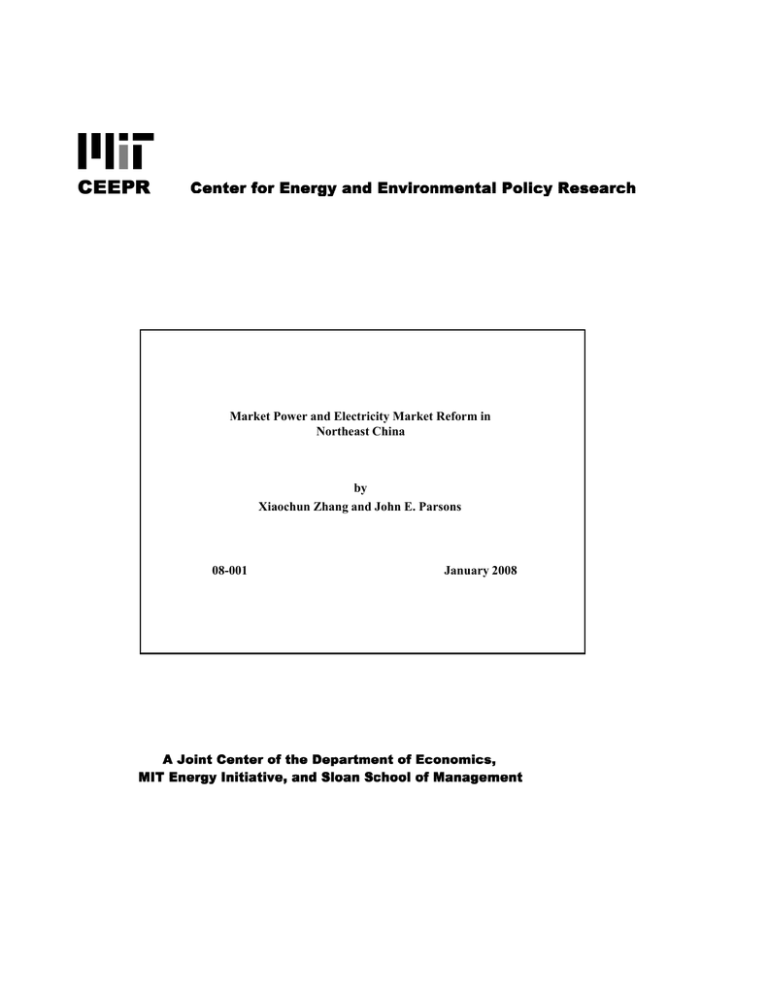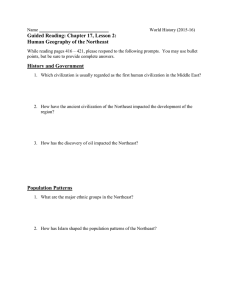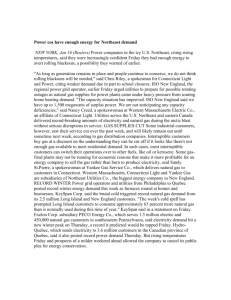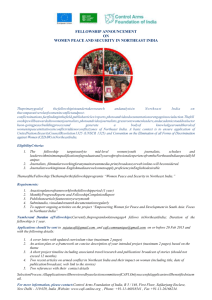Market Power and Electricity Market Reform in Northeast China by
advertisement

Market Power and Electricity Market Reform in Northeast China by Xiaochun Zhang and John E. Parsons 08-001 January 2008 Market Power and Electricity Market Reform in Northeast China Xiaochun Zhang* and John E. Parsons** January 2008 revised June 2008 The Northeast region of China has been used as a testing ground for the creation of a functioning wholesale electric power market. We describe the profile of generation assets throughout the region and the ownership of plants. We calculate the 4-firm Concentration Ratio (CR4) and the Hirschman-Herfindahl Index (HHI). The current ownership structure exhibits modest concentration. We also describe the ownership structure of those plants participating in the trial operation of the Northeast China Regional Electricity Market. Ownership of this subset of plants is much more concentrated. Arguably, this is a troublesome obstacle to instituting some form of competitive bidding in the wholesale power market, and this may be one factor in the poor outcome of the trial operation. INTRODUCTION Since the mid-1980s, the Chinese electricity industry has been undergoing a slow, but thorough reform and institutional transformation.1 In 1985, the central government’s monopoly on the development and ownership of generation was ended, so that various local governments, state-owned enterprises and even private investors—including foreign companies—could develop and own generating facilities. In 1997, the massive * Associate Professor, Department of Economics, School of Business Administration, North China Electric Power University, No. 2 Beinong Road, Changping District, Beijing 102206, P.R. China, zhxch@ncepu.edu.cn, and Visiting Scholar, MIT Center for Energy and Environmental Policy Research, E40-435, 77 Massachusetts Ave., Cambridge, MA 02139 USA, E-mail: zhangxc@mit.edu. ** MIT Center for Energy and Environmental Policy Research, E40-435, 77 Massachusetts Ave., Cambridge, MA 02139 USA, E-mail: jparsons@mit.edu 1 Sources for the following overview of the reform include Austin (2005) Xu (2006), Yeoh and Rajaraman (2004) and especially Zhang and Heller (2004) and International Energy Agency (2006). transmission and generation assets still held by the Ministry of Electric Power were removed from its control and put into a corporate structure, the State Power Corporation, with the objective of encouraging business style governance and management. A parallel corporate restructuring occurred for generation assets controlled by provincial and local government authorities. In 2002, the State Power Corporation of China, which owned 90% of the nation’s transmission assets and 46% of the nation’s generation assets, was broken up. Two major transmission companies were organized on a geographic basis, with the State Grid Corporation of China and its regional and provincial subsidiaries running the system in the north, central and eastern regions, and the China Southern Power Grid Corporation and its regional and provincial subsidiaries running the system in 5 provinces in the south. The major generation assets were divided up to form 5 large ‘gencos’ operating across regions: the Huaneng Group, the Datang Corporation, the Huadian Corporation, the Guodian Corporation and the China Power Investment Corporation. The State Electricity Regulatory Commission was created to oversee the industry, although the National Development and Reform Commission was tasked with managing the industry’s contribution to the national economic goals and so remains involved with key strategic decisions about the industry’s structure, including price policies. In 2003, the government outlined its goal of developing regional wholesale power markets and the efficient exchange of power between regions (see State Electricity Regulatory Commission of China, 2003a). This was preceded by a set of small experiments with competitive bidding for power in 5 provinces and 1 city. The provinces of Liaoning, Jilin, and Heilongjiang together conducted one experiment, while the Page 2 provinces of Zhejiang and Shandong and the city of Shanghai each conducted separate experiments. These covered a very small portion of capacity in each territory, began with only simulated bidding in mid-2000, and were quickly suspended in 2001 when economic growth created power shortages everywhere. In restarting the push towards markets for power, the Northeast region was selected to pioneer the effort. Simulated bidding was conducted in 2004, and trial operations began in 2005 and 2006. These trials had problems. Despite the significant publicity around the creation of this and other regional markets, it is not clear whether the trials will be followed up with actual implementation and whether these markets will soon take any meaningful role in matching supply and demand in any region. One key question is whether the ownership of the generation assets in the Northeast region is sufficiently competitive to support market bidding for wholesale power—see Sun et al. (2003). Our paper addresses this issue. We describe the ownership structure of the generation assets for the region as a whole and broken down by province. We also describe the ownership structure of the generation assets selected to participate in the trial operation of the Northeast China Regional Electricity Market in 2005 and 2006. We calculate the 4-firm Concentration Ratio (CR4) and the Hirschman-Herfindahl Index (HHI). The current ownership structure exhibits modest concentration. Ownership of the subset of plants participating in the trial operation of the Regional Market is much more concentrated. Arguably, this is a troublesome obstacle to instituting some form of competitive bidding in the wholesale power market, and this may be one factor in the poor outcome of the trial operation. Page 3 2. THE STRUCTURE OF THE ELECTRICITY INDUSTRY IN NORTHEAST CHINA For electric power purposes, the Northeast region of China encompasses the three provinces otherwise considered China’s northeast region – Liaoning, Jilin and Heilongjiang – plus the eastern portion of the Inner Mongolia Autonomous Region, encompassing the Chifeng, Tongliao, Hinggan and Hulun Buir areas of the Region. This region is shown in Figure 1. This is the transmission territory covered by the Northeast China Grid Company, Ltd., a subsidiary of the State Grid Corporation. The first three provinces lie directly northeast of Beijing running from the northern edge of the Yellow Sea and along the borders with North Korea and siberian Russia. At the southern tip of Liaoning is the major port of Dalian. Running directly northeast from there on a straight line are the three cities Shenyang, Changchun and Harbin, capitals of their respective provinces, Liaoning, Jilin and Heilongjian. On the western border of these three provinces is the eastern portion of Inner Mongolia. The full territory of Inner Mongolia has a wide east-west axis spanning much of the border with neighboring Mongolia and reaching north up to the border with siberian Russia. The eastern portion of Inner Mongolia that is incorporated in the Northeast grid starts north and east of Beijing and runs north from there. In the remainder of this paper we will refer to “four provinces” without qualification, understanding that the fourth is this eastern portion of the Inner Mongolia Autonomous Region. The Northeast region encompasses a territory of 1,249 thousand kilometers square, a population of 120 million, and a GDP of ¥2,109 billion (Yuan) or ¥17,600 per capita. The region generated 238 terawatt hours of electricity in 2006, consuming 236 of Page 4 them or 1,961 kwh per capita. Table 1 shows how these figures break down by province. Although Liaoning is the smallest province, it has the largest population and more than 40% of the GDP and generation and more than 50% of the electricity consumption. Eastern Inner Mongolia, while the largest territory in the region—approximately equal to that of Heilongjiang—has the smallest population and the lowest GDP per capita. The per capita GDP of Liaoning is nearly twice that of the eastern Inner Mongolian province. The provinces of Jilin and Heilongjiang appear very similar on a per capita basis, with Heilongjiang being slightly larger and more populous. The three provinces of Liaoning, Jilin and Heilongjiang all have a long history of investment in heavy industry, including iron and steel. Heilongjiang, in particular, has significant oil and coal deposits and relies as well on timber production. Liaoning has in recent years enjoyed the benefit of a growing chemical industry. The eastern portion of Inner Mongolia is more rural and agricultural, although Inner Mongolia as a whole also enjoys major coal deposits and some significant related heavy industry. In the years following China’s Reform and Opening, the Northeast Region did not enjoy the same level of growth as some other parts of China. However, in 2003 the country adopted a Northeast China Revitalization plan targeting economic growth there. The Northeast region was one of the few areas of China to be experiencing a surplus in generating capacity in recent years, and the transmission system was relatively good. It had relatively comparable retail tariffs in the three provinces of Liaoning, Jilin and Heilongjiang, as well as relatively comparable levels of economic development—see Zheng and Heller (2004), International Energy Agency (2006) and Yeoh and Rajaraman Page 5 (2004). These were important factors in the selection of the Northeast region to pioneer reforms and the development of a wholesale market. Across China, the grid and the dispatch of generation functioned largely on a provincial basis. There was little exchange of power across provinces even when one province had a surplus of power and another a shortage (see China Daily, 2004). This was due both to inadequate transmission lines as well as to the rules and incentives for dispatch. In the Northeast region there are often constraints in delivering power from the north to the south—from Heilongjiang into Jilin and from Jilin into Liaoning. One of the goals of the reform of the electricity industry is integration of the transmission grid across provincial boundaries by setting up regional grids which are intended to develop unified scheduling, management, accounting, and investment planning (see State Electricity Regulatory Commission of China, 2003b). The Northeast China Grid is organized in three components: the South Grid, consisting of the province of Liaoning and the area of Chifeng in Inner Mongolia, the Central Grid, consisting of the province of Jilin and the areas of Tongliao and Hinggan in Inner Mongolia, and the North Grid, consisting of the province of Heilongjiang and the area of Hulun Buir in Inner Mongolia. We focus our attention on the ownership structure of the generation assets in the region. We began with a 2007 publication of the Development and Planning Department of the State Grid Corporation of China, the Comprehensive Statistical Data and Materials 2006.2 Underlying this document is a complete listing of power plants in the region, their capacity, generation, fuel type, ownership and other information. However, this detail is not all publicly available. The document reports summary information along 2 The document is in Chinese and the original title is given in the list of references. Page 6 a number of different dimensions. It also individually lists installations with a capacity of 6 MW or more, showing their capacity and generation and location by province, but not the fuel type or ownership. Often the name of the plant makes the fuel type clear. Alternatively, we found the plant on the web and identified its fuel type or determined it from other information. For information on ownership of the individual installations, we turn first to a 2007 publication of the Northeast China Bureau of the State Electricity Regulatory Commission of China, the Annual Report on Electricity Regulation of Northeast China for 2006.3 Part 5 of this report lists the large thermal plants owned by each of the five major gencos. This corresponds to 34 installations with 17,151 MW of capacity, or 36% of our sample of plants with capacity greater than 6 MW. No other owners are listed individually. To determine the ownership of the remaining plants, we search the web using the plant name. In many cases we can find an owner for the plant: 218 installations with 27,487 MW of capacity, or 58%. Where we cannot, we treat the plant as if it is independently owned: the remaining 126 installations with individual capacity above 6 MW, accounting for 2,841 MW in total or 6%. Failure to have identified the true owner of some plants will bias our results slightly towards a lower measure of concentration.4 3 The document is in Chinese and the original title is given in the list of references. 4 In the remainder of this paper, we treat all plants as if they have a single owner. This is consistent with how the original sources handle the classification of ownership. However, this is not always the case. Some plants have multiple large shareholders, and in some cases power purchase contracts may alter exactly who controls the marketing of power from the plant. But the original sources have made an evaluation of who is the single controlling owner, and we have accepted that classification. We have not been able to deepen our database to have an accurate picture of the ultimate shareholder structure nor do we have information about contractual rights to the power. A more complete picture of this information could potentially alter our assessment of the measure of concentration. But attention to the ultimate shareholder structure would also have to address the problem that the state possesses a controlling stake in all five major gencos, as well as the State Grid Corporation, so that some decision has to be made about whether management decisions are being made independently at each company. This same judgment would have to be extended to treatment Page 7 Using this data we provide some simple descriptive statistics about the generation assets in the Northeast region, and then we turn to an analysis of ownership concentration. All of the statistics reported appear in Table 2. The Northeast region has a total of 47,880 MW of generation capacity produced in 578 installations.5 The regional breakdown of the capacity is 38% in Liaoning, 23% in Jilin, 28% in Heilongjiang, and 10% in eastern Inner Mongolia. The average capacity of an installation is 83 MW, but the distribution of installation sizes is very skewed. There are 11 installations with a capacity of greater than 1,000 MW, although an installation can consist of several units. These large installations represent 31% of capacity in the region. There are 18 installations with a capacity between 1,000 and 500 MW, representing 26% of capacity. Another 58 installations have a capacity between 500 and 100 MW, representing 28% of capacity. There are 491 installations with a capacity less than 100 MW, a good many of which are smaller than 6 MW. These 491 small installations provide 15% of capacity. Table 2 shows this profile for the region as a whole and for the four provinces, individually. The only notable provincial distinctions are that Jilin has a smaller fraction of installations greater than 1,000 MW, while eastern Inner Mongolia has fully 50% of its capacity in such very large installations and a much smaller share of capacity, in small installations of less than 100 MW—7% for eastern Inner Mongolia versus 15% for the region as a whole. of the plants controlled by various provincial governments or by other state owned corporations. In our analysis we treat all of these different state owned entities as if they were managed entirely independent of one another. 5 The document shows 582 installations. We identify two listed installations that show zero generation capacity and which we assume are under construction. The remaining discrepancy of two is, we believe, due to double counting within the original document. Page 8 Fully 85% of the Megawatt capacity is thermal power. These are overwhelmingly coal-fired units, although the documents do not provide a further breakdown between coal, oil and gas fired thermal plants. Most of the remaining capacity, 13%, is hydro power, and 2% of capacity is wind power. There are currently no nuclear plants in the Northeast region, although construction began in 2007 on a plant in Liaoning province which is scheduled to come on line in 2012. Table 2 shows this profile for the region as a whole and for the four provinces, individually. Liaoning and Heilongjiang are even more dependent on thermal installations, while in Jilin fully 35% of capacity is hydropower. Some 15% of the capacity is in installations built for self-generation, so that only the remaining 85% is sold. The portion of capacity used for self-generation is as low as 10% in eastern Inner Mongolia and rises to 21% in Heilongjiang. Much of the capacity is in units providing combined heat and power. Of the 378 plants with capacity greater than 6 MW, 200 of them are listed as units with at least some, if not all, capacity for heating. The total MW dedicated to heating is 18,424 MW of 47,478 MW, or 33%. Five of the six largest capacity owners are the gencos assigned the generation assets of the former State Power Corporation in 2002. The other large capacity owner is the State Grid Corporation that was also assigned some of these generation assets. As shown in Table 2, the Datang Corporation has 9% of the assets, the Guodian Corporation has another 9%, the Huadian Corporation has 14%, the Huaneng Corporation has 11%, and the China Power Investment Corporation has 12%. The State Grid Corporation has 13% of the assets, consisting 75% of hydro power and 25% of one large thermal station in eastern Inner Mongolia. The remaining 33% of capacity is divided among other Page 9 companies. There are only 2 companies outside of the 5 gencos and the State Grid Corporation that owns more than 2% of capacity. One is Guohua Electric Power Corporation, 3.4% of capacity, and the other is Jinzhou Eastern Power Corporation, 2.5% of the capacity. Both are in Liaoning Province. Table 2 also shows this ownership breakdown by province. There are some marked differences with the regional profile, since certain gencos are absent from certain provinces and have a very large presence in other provinces. Liaoning is notable for the large percentage of power not owned by the 5 gencos nor by the State Grid—fully 53%. Jilin and eastern Inner Mongolia have the most capacity in the hands of these 6 corporations, 86% and 87%, respectively. In Jilin, with its large hydropower resources, the State Grid has 31% of the capacity. The State Grid also has 30% of the capacity in eastern Inner Mongolian due to the one very large thermal installation it owns which is Yuanbaoshan. Table 3 shows the 4 firm Concentration Ratio and the Hirschman-Herfindahl Index calculated for the Northeast Region as a whole. The CR4 is 50% while the HHI is 770, indicating a low level of concentration for the region as a whole. 6 Table 3 also shows the CR4 and HHI when calculated excluding self-generation, since arguably these units would be less readily incorporated into a competitive market. Excluding selfgeneration moves the region-wide HHI from 770 to 1,035, i.e., from below the 1,000 cutoff level to just above it and so into the ‘moderately concentrated’ range. 6 The commonly used benchmarks for the HHI are: (i) an HHI below 1,000 is a low level of concentration, (ii) an HHI above 1,000 and below 1,800 is a moderate level of concentration, and (iii) an HHI above 1,800 is a high level of concentration. These benchmarks are derived from the Horizontal Merger Guidelines issued by the U.S. Department of Justice and the U.S. Federal Trade Commission. Page 10 Table 3 also shows the provincial breakdown of these measures of market concentration. This is important insofar as transmission constraints create pockets of generation with greater market power. In three of the four provinces, the HHI is greater than 1800, indicating a high level of concentration. Only in the province of Liaoning is the HHI below 1000, indicating a low level of concentration. Removing units employed for self-generation does not change the picture with respect to these cutoffs, although it does noticeably raise the measures of concentration in the three provinces of Jilin, Heilongjiang and eastern Inner Mongolia. It may be instructive to compare these concentration measures in the Northeast China Regional Electricity Market with measures for other electricity markets around the world. Several of the independent system operators in the US have a market monitor who calculates and reports these figures for their systems.7 ISO-New England runs the system covering the six New England states of Maine, New Hampshire, Vermont, Massachusetts, Rhode Island and Connecticut. It reports an HHI of 700. The New York System Operator reports an HHI for the three regions of the system: the HHI for Upstate New York was 1,028, for New York City the HHI was 1,843 and for Long Island the HHI was 6,317. The high level of concentration in the two latter regions justifies extra measures to prevent exploitation of market power there. The largest of the ISOs is PJM, which covers New Jersey, Delaware, Maryland, and West Virginia, much of Pennsylvania Virginia and Ohio, and parts of North Carolina, Indiana, Michigan and 7 ISO New England Inc. (2007), New York State Department of Public Service (2006), PJM Interconnection (2007) and Independent Market Monitor for the Midwest ISO (2007). Page 11 Illinois. They report an HHI of 1,256 which is moderately concentrated.8 The Midwest ISO, which covers the remaining portions of Ohio, Indiana, Michigan and Illinois, plus Wisconsin, Iowa, Minnesota, Nebraska, North Dakota and parts of Missouri, South Dakota and Montana, as well as the Canadian province of Manitoba, reports an overall HHI of 567, and breaks this down by 4 sub-territories with HHIs ranging from 1,529 up to 2,813. In Europe, measures of concentration are typically calculated for markets organized according to national boundaries. A recent report by Matthes, Grashof and Gores (2007) shows diverse situations.9 In the England and Wales the HHI had fallen to 616 by 2005, a level markedly below 1,000. In Scandinavia, the level is 974. In Portugal and Spain the level is 1,271. Taking France together with Belgium, the Netherlands and Luxembourg yields an HHI above 4,513 which is obviously a very high level of concentration. In Germany, the HHI of 1,374 is in the moderately concentrated region. In Italy together with Austria and Switzerland, the HHI is 1,024. Interestingly, the report examines the possible creation of a market across national boundaries, encompassing all 8 Caution and care need to be exercised in comparing these HHIs across different countries or reporting territories. As always, the proper calculation of the HHI most crucially depends on a proper identification of the market. In our calculations, we have measured the HHI based on generation capacity and have included all generators within a given region. However, we also made the additional calculation excluding self-generation. The PJM figure is based on energy figures, not simply capacity, and in this sense is not directly comparable. PJM also further refines its figures by calculating an HHI according to the segment of supply provided, be it base load, intermediate, or peaking plants. The intermediate and the peak load segments of the supply curve are markedly more concentrated, with HHIs of 2,664 and 4,157, respectively, on average. The ISO NE figure, however, is based on generating capacity. But our figures for capacity in the Northeast China Region may more liberally include units that were not actually available, while the ISO NE figure is based on units made available for generation. 9 This report highlights another area of caution for analysis of the HHIs across different countries since it takes care to incorporate additional information about control of a plant exercised through contractual arrangement and not through direct ownership. As mentioned earlier, our analysis of ownership in China does not incorporate any additional measures of control through contract or other means. Page 12 of the continental countries listed above. They report an HHI of 1,410 for this theoretical region-wide market. 3. TRIAL OPERATION OF THE NORTHEAST CHINA REGIONAL ELECTRICITY MARKET Development of the system of regional grids and improved connections across regions is also seen as a step in the process leading to competitive wholesale power markets. One of the state gencos explained to investors: The long-term objective for the electricity pricing reform is to establish a standardized and transparent tariff setting mechanism, classifying the electricity prices into the on-grid price, the transmission price, the distribution price and the end-user retail price, and to allow the on-grid prices and retail prices to be determined through market competition. The transmission and distribution prices are to be regulated by the government. (Huaneng Power International, 2005, p. 14) The Northeast and the East grid regions were to begin this process. The Northeast China Regional Electricity Market began simulated operation in January of 2004 and trial operation in 2005—see the International Energy Agency (2006). Trading in the Northeast Market is conducted on the Northeast Power Exchange located in Shenyang, the capital of Liaoning province. The simulated and 2005 trial operation of the Northeast China Regional Electricity Market involved the participation of 28 plants.10 Initially, a portion of each plant’s normal volume of generation was assigned to be bid into the market, and later all of each plant’s volume was assigned.11 Bidding was either for annual dispatch or 10 Some reports refer to more than 20 “companies” or more than 20 “generators”, perhaps suggesting a high level of competition. As we report shortly below, when the trial operation began in 2005, only 10 companies owned the 28 plants. As a result of the withdrawal of certain plants as well as ownership changes, in 2006 only 8 companies owned the 26 plants participating in the trial operation. 11 Here again, though the terminology can be tricky. Where a given installation has multiple generators, only certain units were assigned to the competitive market. Page 13 for monthly dispatch. The bidding would set an energy charge, with a separate capacity charge being set by other rules outside of the structures of the competitive market. In the Northeast region the trial operations were suspended in early 2006, resumed in March 2006, and suspended again. The bidding results in 2006 were not used for actual settlements and the future operation of the market is under review (see Huaneng Power International, 2007). In China’s East region market, simulated operation began in 2005 and a pair of trial operations occurred in 2006 which involved actual settlements. A market has also been created in the South region with simulated operation in 2006. We have found little public data about these various simulations or trial operations and little public discussion of what may be the nature and cause of any problems. We turn attention to the level of concentration in ownership of generation assets as one possible cause of the problems. When the trial operation of the Northeast China Regional Electricity Market was begun, a specific subset of the region’s power plants was selected to participate. The 2007 publication of the Northeast China Bureau of the State Electricity Regulatory Commission of China, the Annual Report on Electricity Regulation of Northeast China for 2006, identifies for us which plants—indeed, which units of the plants—participated in the trial operation of the Northeast China Regional Electricity Market in 2006. For 2005 we found in Han Shui (2005) and in Electricity Market Research Institute of North China Electric Power University (2005) a summary breakdown of the companies participating in the trial operation in 2005 and their capacities. But these two sources did not report on the individual plants and their capacities. However, through private Page 14 correspondence with the State Grid Corporation of China (2008) we received a listing of the participating plants, their owners and their capacities. We use these sources to produce Tables 4 and 5 which list the plants participating in the trial operation in 2005 and 2006, respectively, together with their capacity and their owner.12 In 2005, the total capacity of participating plants was 21,486 Megawatts from 28 different plants. The two largest owners of participating plants are Huadian with 25% of capacity and Huaneng with 23% of capacity. The CR4 and HHI for the 2005 trial operation of the Regional Market can be calculated from the data in Table 4 and are shown in Table 3: the CR4 is 70% and the HHI is 1,582, which is within the region normally labeled ‘moderately concentrated’. This is markedly higher than the HHI for the region’s total generating assets, even excluding self-generation. This contrast suggests there is potential for competition that was not taken advantage of in designing the trial market structure. In 2006, two of the plants had dropped out of the trial operation, so that the total capacity of participating plants was 20,260 Megawatts from 26 plants. Also, one of the previously independent plants, Hunjiang, becomes owned by CPIC, raising CPIC’s share 12 There are some minor discrepancies between sources. The Hunjiang plant is shown by some to be independent and by others to be owned by CPIC. Our internet search shows that CPIC took ownership in July 2005. We list it as independent for 2005 but owned by CPIC in 2006. The Annual Report states that participation was limited to thermal plants with individual unit capacity greater than 100 MW and excluding those used for combined heat and power or for self-generation. We can identify units meeting the criteria for participation in the trial that, nevertheless, were not included. Moreover, some of the units that did participate appear to be combined heat and power units. For example, the Mudanjiang No. 2 thermal station in Heilongjiang province is a participant, although 400 MW of 1,020 MW is heating. Also in this category are the Qitaihe No. 1 and the Jiamusi thermal stations in Heilongjiang, and the Hunjiang and Huichun thermal stations in Jilin. Also, in certain cases, some of the units at a given plant were selected to participate, but not the other units. The Annual Report for 2006 shows Shuangliao as a single installation with a capacity of 1200 Megawatts, while the private correspondence for 2005 shows a Shuangliao Co. and a Shuangliao plant, each with 600 Megawatts, and this is how we have listed it for both 2005 and 2006. Since either way the full 1200 Megawatts is owned by Guodian this does not affect the calculation of HHI. Page 15 of the trial market to 14%. Otherwise the picture in 2006 is very similar to 2005. As shown in Table 3, the CR4 is 76% and the HHI is 1,759, just slightly below the benchmark for high concentration. Table 3 also shows the provincial breakdown of these measures of market concentration. The HHI is greater than 1800 in each of the provinces, indicating a high level of concentration. In Heilongjiang, the HHI is even greater than 4000. Given the problem with transmission constraints between provinces, there might be significant concentrations of market power in these provinces for participants in the trial operation. 4. CONCLUSIONS We analyze the concentration of ownership of generation assets in the Northeast region of China, a region that has been put on the forefront in the national plan for the creation of a wholesale electric power market. The government’s allocation of generation to the 5 gencos was crafted to limit the concentration of assets, and our results for the region as a whole show a low level of concentration in the Northeast. However, because transmission constraints between provinces are often binding, it may be important to look at concentration at the provincial level. Here we see that the generation assets are often much more concentrated, with the exception of the province of Liaoning where there is significant self-generation and many independent producers. In order to realize the full benefits of the ownership structure at the region-wide level, it would be necessary to invest in additional generation to relieve congestion between the provinces. Alternatively, efforts could be made to reduce ownership concentration at the provincial level or to mitigate the exercise of market power. This paper does not explore the effectiveness of these options. Page 16 The trial operation of the Northeast Regional Electricity Market in 2005 and 2006 was conducted using only a subset of the region’s generating assets. This subset exhibits a much stronger level of ownership concentration than the region as a whole. Arguably, this is a troublesome obstacle to instituting some form of competitive bidding in the wholesale power market, and this may be one factor in the poor outcome of the trial operation. Page 17 References Chinese language sources: Development and Planning Department of the State Grid Corporation of China, 2007, Comprehensive Statistical Data and Materials 2006. In the original Chinese this source is 国家电网发展策划部, 2006 年统计资料汇编. Electricity Market Research Institute of North China Electric Power University, 2005, Appraisal on Trial Operations in Northeast China Regional Electricity Market. In the original Chinese this source is 华北电力大学电力市场研究所,东北区域电力市场试 运行评价 Northeast China Burea of the State Electricity Regulatory Commission of China, 2007, Annual Report on Electricity Regulation of Northeast China (2006). In the original Chinese this source is 国家电力监管委员会东北监管局, 东北区域电力监管年度 报告(2006). Accessed at http://dbj.serc.gov.cn/djjnWeb/main_info/ak.do?infoId=20070724102913636204 935365474530 . State Electricity Regulatory Commission of China, 2003a, Guidelines for Establishing Regional Markets (Electricity Regulation Market [2003] No.21). In the original Chinese this source is 国家电力监管委员会, 关于印发区域电力市场建设指导意见的通知 (电监市场[2003]21 号). Accessed at http://211.160.24.247/html/2007/110.htm. State Electricity Regulatory Commission of China, 2003b, Northeast China Regional Power Market Implementation Plan. In the original Chinese this source is 国家电 力监管委员会. 东北区域电力市场实施方案 . Accessed at http://dbj.serc.gov.cn/djjnWeb/staticinfo/list.do?infoId=200609281436137513694 74000982760&staticinfo=20060924094656717277021863632514. State Grid Corporation of China, 2008, private correspondence, Information on Bidding Plants in 2005. In the original Chinese this source is 国家电网公司, 2005 年各竞价电 厂信息 English language sources: Austin, Angie, 2005, Energy and Power in China: Domestic Regulation and Foreign Policy, London: Foreign Policy Centre. China Daily, 2004, Landmark power grid switches on, September 29. Page 18 Han Shui, 2005, Northeast China Regional Power Market, presentation to the First Annual Meeting of CAREC Members Electricity Regulators Forum. Huaneng Power International, Inc., 2005, Announcement of Results for 2004. Huaneng Power International, Inc., 2007, Annual Report on Form 20-F, 2006. Independent Market Monitor for the Midwest ISO, 2007, 2006 State of the Market Report for the Midwest ISO. International Energy Agency, 2006, China’s Power Sector Reforms. Where to Next?, Paris: IEA. ISO New England Inc., 2007, 2006 State of the Market Report. Matthes, Felix Chr., Katherina Grashof and Sabine Gores, 2007, Power Generation Market Concentration in Europe 1996-2005. An Empirical Analysis, Berlin: ÖkoInstitut e.V. New York State Department of Public Service, 2006, Staff Report on the State of Competitive Energy Markets: Progress to Date and Future Opportunities. PJM Interconnection, 2007, 2006 State of the Market Report. Sun, X., et al., 2003, Analysis on the competition of generating market in the ongoing power market of China, Proceedings of the 6th Conference on Advances in Power System Control, Operation and Management, APSCOM, Hong Kong, 846-849. Xu, Shaofeng, and Wenying Chen, 2006, The reform of electricity power sector in the PR of China, Energy Policy 34, 2455-2465. Yeoh, Boon-Siew, and Rajesh Rajaraman, 2004, Electricity in China: the latest reforms, Electricity Journal, April, 60-69. Zhang, Chi, and Thomas C. Heller, 2004, Reform of the Chinese electric power market: economics and institutions, Stanford University Program on Energy and Sustainable Development Working Paper #3 (Revised). Page 19 Figure 1 Territory of the Northeast China Regional Electricity Market Table 1 Provincial Breakdown of Key Regional Statistics, 2006 Territory Population (thous. km sq) [a] [b] [1] Northeast Region [2] [3] [4] [5] Liaoning Jilin Heilongjiang E. Inner Mongolia 1,249 146 187 454 462 (million) [c] [d] 120 12% 15% 36% 37% 43 27 38 12 GDP (billion Yuan) [e] [f] 2,109 36% 23% 32% 10% 926 425 622 136 44% 20% 29% 6% Electricity Generation per capita (Yuan) [g] (Twh) [h] 17,600 238 21,700 15,600 16,300 11,400 101 46 65 27 [I] Electricity Consumption per capita (Twh) (kwh) [j] [k] [l] 236 42% 19% 27% 11% 123 41 60 12 1,961 52% 18% 25% 5% 2,876 1,515 1,562 986 Table 2 Profile of Generating Assets in the Northeast Region and by Province Northeast Region Capacity, MW percent of NE region 47,881 Liaoning Jilin 18,338 38% Heilongjiang 11,131 23% 13,425 28% e. Inner Mongolia 4,987 10% Size of Installations > 1,000 MW 500-1,000 MW 100-500 MW < 100 MW 14,632 12,678 13,221 7,351 31% 26% 28% 15% 6,600 2,685 5,907 3,147 36% 15% 32% 17% 1,700 4,383 3,560 1,489 15% 39% 32% 13% 3,820 4,810 2,441 2,354 28% 36% 18% 18% 2,512 800 1,314 361 50% 16% 26% 7% Type of Generation Thermal Hydro Wind Other 40,606 6,402 851 22 85% 13% 2% 0% 16,721 1,401 207 9 91% 8% 1% 0% 7,039 3,872 208 13 63% 35% 2% 0% 12,456 853 115 0 93% 6% 1% 0% 4,390 276 321 0 88% 6% 6% 0% Outlet Sold Self-Generation 40,896 6,985 85% 15% 15,418 2,920 84% 16% 10,329 803 93% 7% 10,664 2,761 79% 21% 4,486 501 90% 10% Ownership Datang Guodian Huadian Huaneng CPIC State Grid Other 4,079 4,219 6,472 5,231 5,981 6,083 15,816 9% 9% 14% 11% 12% 13% 33% 0 1,050 1,200 2,740 3,028 545 9,776 0% 6% 7% 15% 17% 3% 53% 2,309 2,239 0 249 1,300 3,428 1,606 21% 20% 0% 2% 12% 31% 14% 1,600 930 5,272 1,230 0 610 3,783 12% 7% 39% 9% 0% 5% 28% 170 0 0 1,012 1,653 1,500 652 3% 0% 0% 20% 33% 30% 13% Table 3 Measures of Concentration in the Northeast Region Excluding All Facilities Trial Operation of Regional Market 2005 Self-Generation 2006 CR4 [a] HHI [b] CR4 [c] HHI [d] CR4 [e] HHI [f] CR4 [g] HHI [h] [1] Northeast Region 50% 770 58% 1,035 70% 1,582 76% 1,759 [2] [3] [4] [5] Liaoning Jilin Heilongjiang E. Inner Mongolia 44% 83% 67% 87% 580 1,925 1,837 2,427 51% 89% 84% 96% 803 2,202 2,850 2,952 78% 100% 100% 100% 1,905 3,194 4,295 3,572 90% 100% 100% 100% 2,289 3,740 4,292 3,572 Note: We have no ownership data for the 1% of MW capacity in plants below 6MW in size. In calculating the HHI we add zero to the HHI calculation for these plants. We also cannot match the self-generation capacity total with individual plants. To make this calculation, we assume that all of the self-generation is from units owned by companies other than the 5 gencos or the State Grid. Table 4 Participants in the Trial Operation of the Northeast China Regional Electricity Market in 2005 Owner [a] [1] [2] [3] [4] Datang Datang Datang Datang Name [b] Changshan Huichun Qitaihe Liangzihe Province [c] Jilin Jilin Heilongjiang Heilongjiang Capacity in MW Installation Company [d] [e] 400 200 706 100 Market Share Installation Company [f] [g] 2% 1% 3% 0% 1,406 [5] [6] [7] [8] Guodian Guodian Guodian Guodian Shuangliao Co. Shuangliao Plant Shuangyashan Chaoyang Jilin Jilin Heilongjiang Liaoning 600 600 820 400 7% 3% 3% 4% 2% 2,420 [9] [10] [11] [12] [13] Huadian Huadian Huadian Huadian Huadian Fulaerji Jiamusi Harbin No. 3 Mudanjiang No. 2 Tieling Heilongjiang Heilongjiang Heilongjiang Heilongjiang Liaoning 1,200 400 1,600 1,020 1,200 11% 6% 2% 7% 5% 6% 5,420 [14] [15] [16] [17] [18] [19] [20] Huaneng Huaneng Huaneng Huaneng Huaneng Huaneng Huaneng Dalianwan Yingkou Dandong Yimin Hegang Xinhua Changshan Huaneng Liaoning Liaoning Liaoning Inner Mongolia Heilongjiang Heilongjiang Jilin 1,400 640 700 1,000 600 400 200 25% 7% 3% 3% 5% 3% 2% 1% 4,940 [21] CPIC [22] CPIC [23] CPIC Tongliao Fuxin Qinghe Inner Mongolia Liaoning Liaoning 800 200 1,200 23% 4% 1% 6% 2,200 [24] State Grid Yuanbaoshan Inner Mongolia 10% 1,500 1,500 7% 7% 400 400 2% 2% [25] Independent Hunjiang Jilin [26] Independent Suizhong Liaoning 1,600 1,600 7% 7% [27] Independent Nenggang Liaoning 400 400 2% 2% [28] Independent Jinzhou Liaoning 1,200 1,200 6% 6% Total 21,486 100% Table 5 Participants in the Trial Operation of the Northeast China Regional Electricity Market in 2006 Owner [a] [1] [2] [3] [4] Datang Datang Datang Datang Name [b] Changshan Huichun Qitaihe Liangzihe Province [c] Jilin Jilin Heilongjiang Heilongjiang Capacity in MW Installation Company [d] [e] 405 200 700 100 Market Share Installation Company [f] [g] 2% 1% 3% 0% 1,405 [5] [6] [7] [8] Guodian Guodian Guodian Guodian Shuangliao Co. Shuangliao Plant Shuangyashan Chaoyang Jilin Jilin Heilongjiang Liaoning 600 600 830 400 7% 3% 3% 4% 2% 2,430 [9] [10] [11] [12] [13] Huadian Huadian Huadian Huadian Huadian Fulaerji Jiamusi Harbin No. 3 Mudanjiang No. 2 Tieling Heilongjiang Heilongjiang Heilongjiang Heilongjiang Liaoning 1,200 400 1,600 1,020 1,200 12% 6% 2% 8% 5% 6% 5,420 [14] [15] [16] [17] [18] [19] Huaneng Huaneng Huaneng Huaneng Huaneng Huaneng Dalianwan Yingkou Dandong Yimin Hegang Xinhua Liaoning Liaoning Liaoning Inner Mongolia Heilongjiang Heilongjiang 1,400 600 700 1,000 600 400 27% 7% 3% 3% 5% 3% 2% 4,700 [20] [21] [22] [23] CPIC CPIC CPIC CPIC Hunjiang Tongliao Fuxin Qinghe Jilin Inner Mongolia Liaoning Liaoning 605 800 200 1,200 23% 3% 4% 1% 6% 2,805 14% Inner Mongolia 1,500 1,500 7% 7% [25] Independent Suizhong Liaoning 1,600 1,600 8% 7% [26] Independent Nenggang Liaoning 400 400 2% 2% [24] State Grid Total Yuanbaoshan 20,260 100% Note: There are some minor discrepancies in the capacities of plants reported for 2006 as compared against 2005, but as this makes no material difference to the results, we have not attempted to clarify the sources of these discrepancies.








